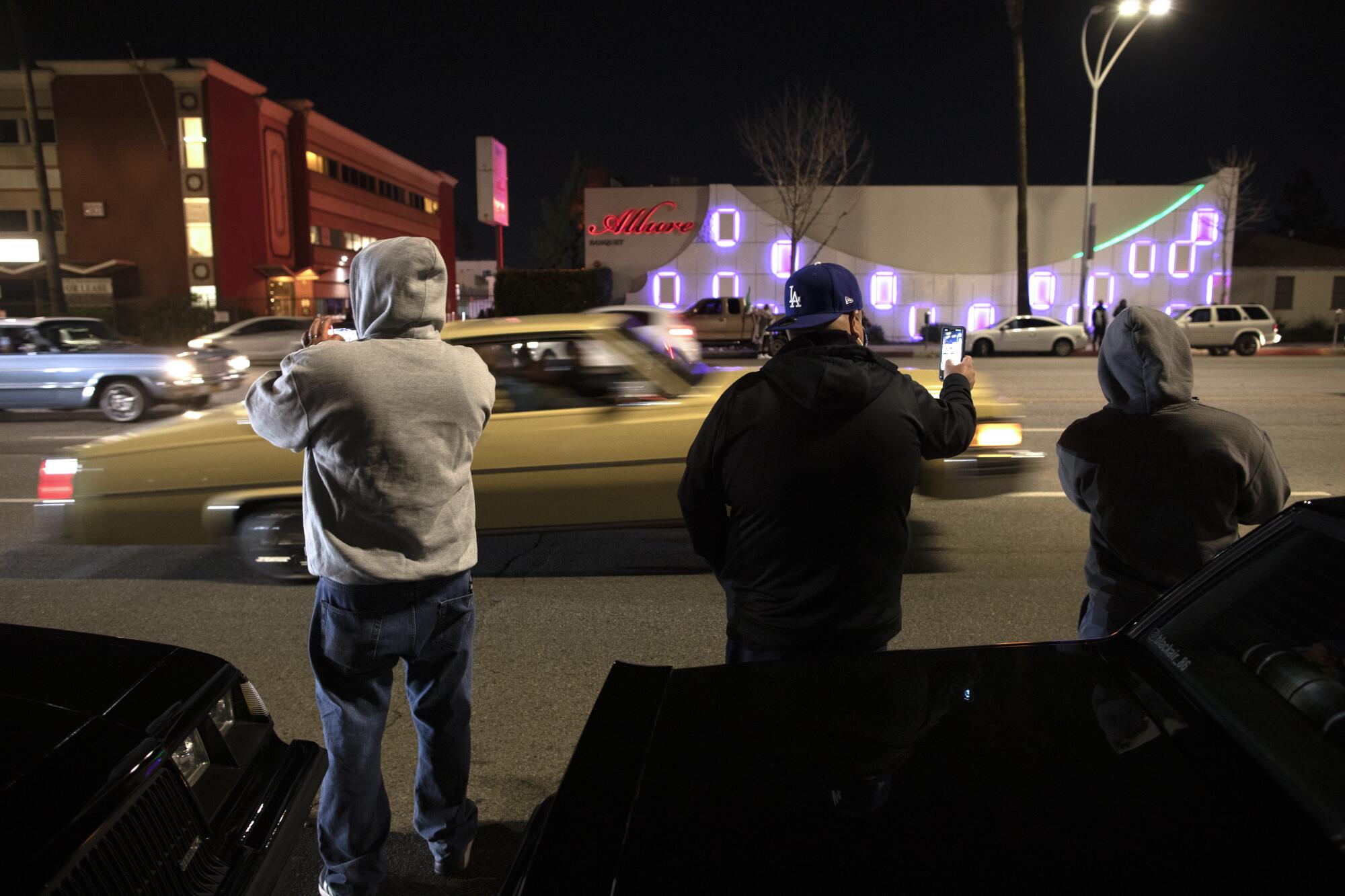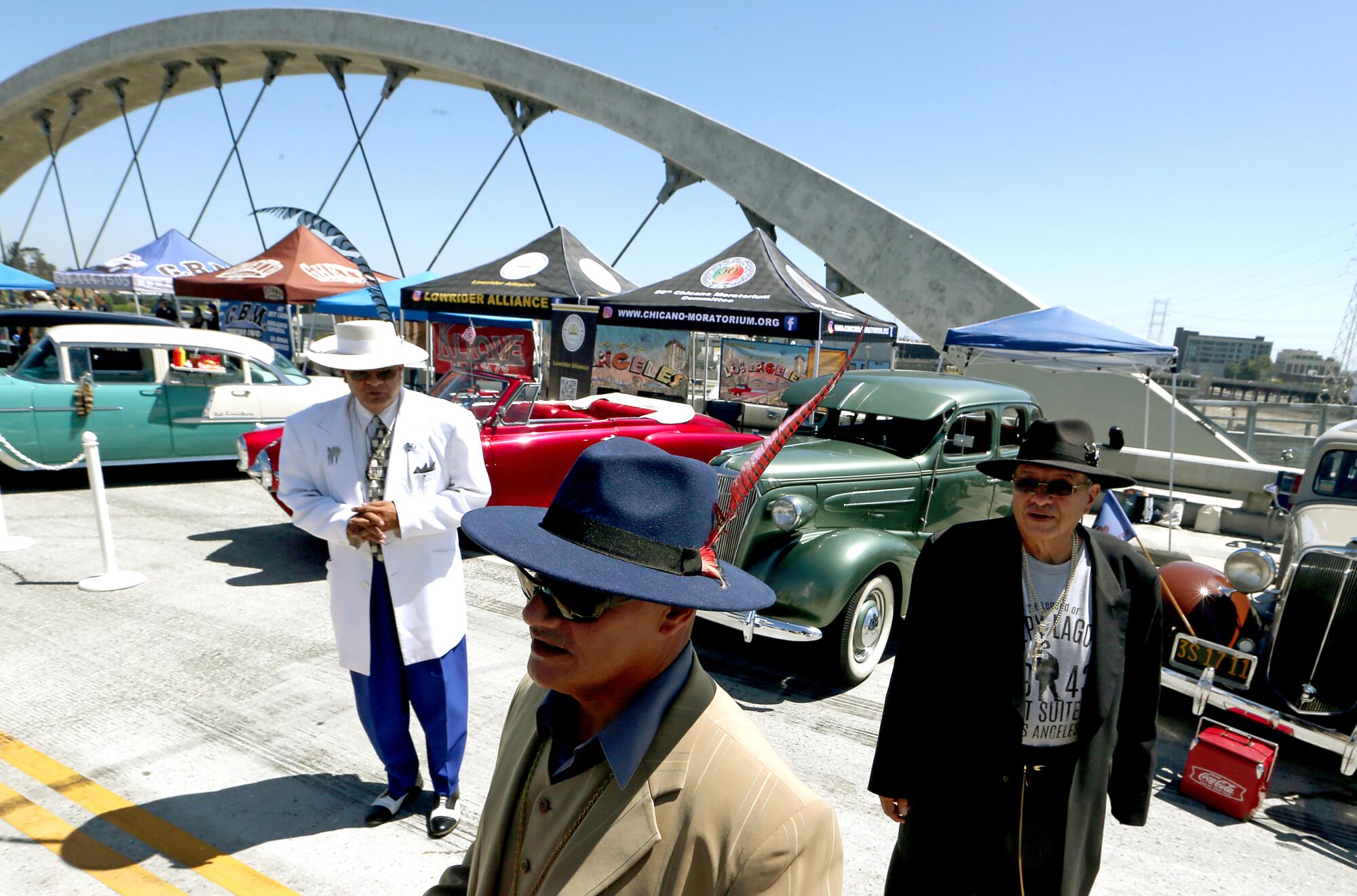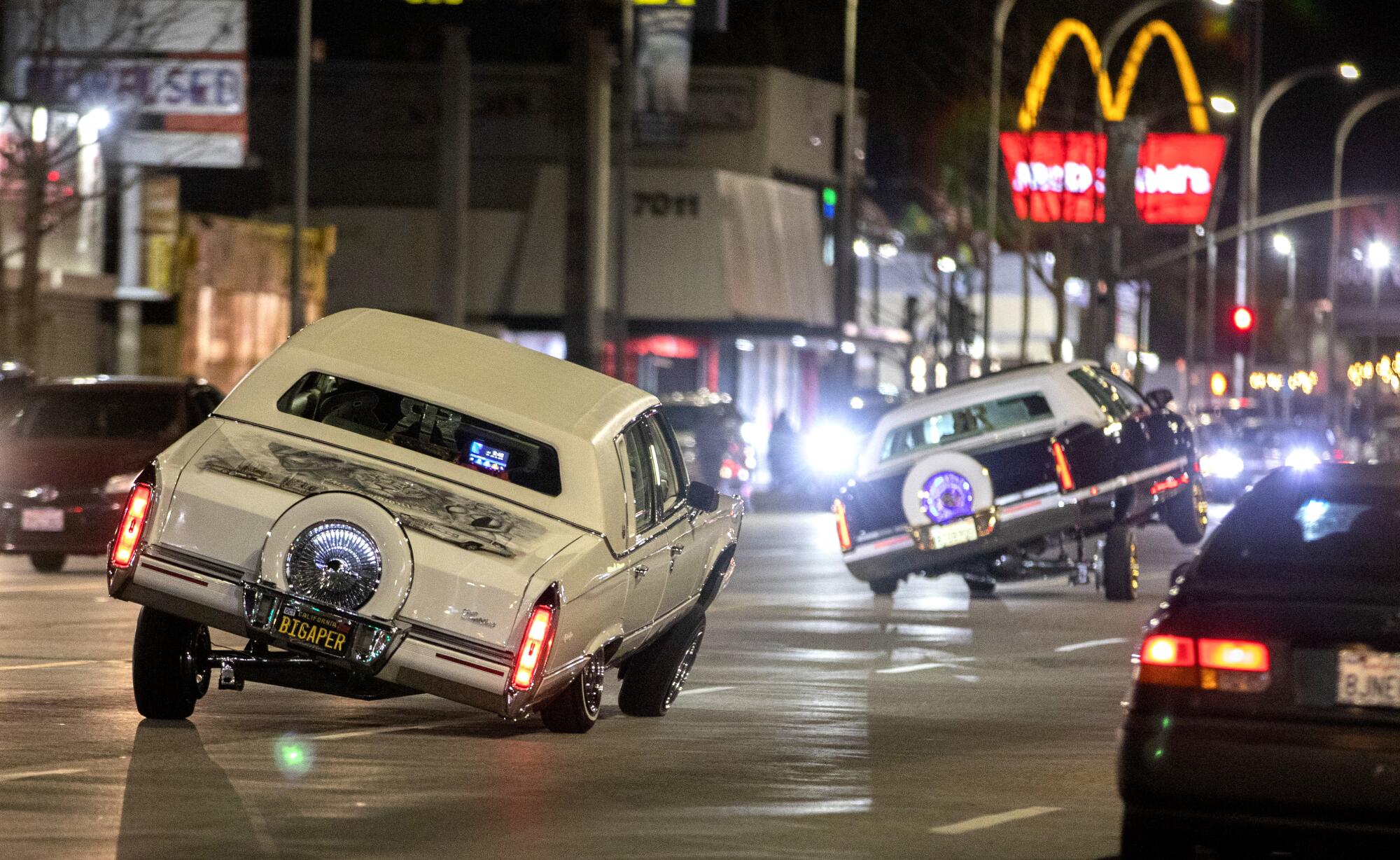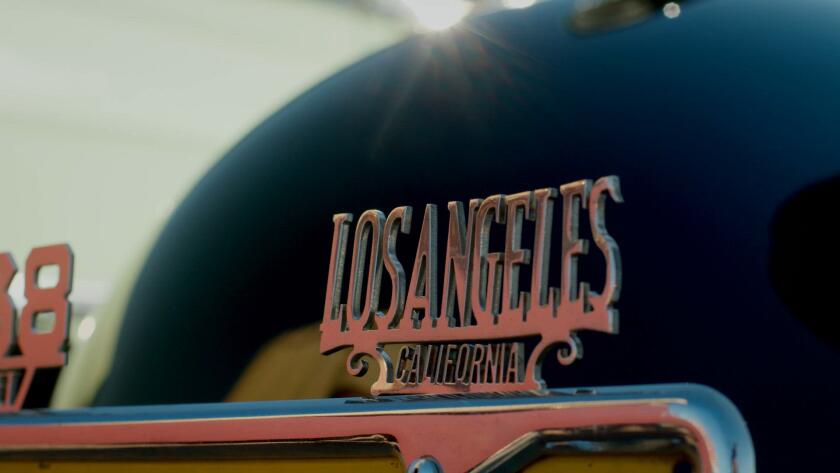
- Share via
As a teenager in the 1970s, Jovita Arellano would perch in the window of her family’s National City apartment to watch the candy-colored parade of lowriders cruise down Highland Avenue.
She loved how the light reflected off their chrome rims and the gleam of paint that had been meticulously polished. Cars would ride so close to the ground that any small shift in weight caused their undercarriages to scrape against the pavement.
“I’m going to get a lowrider,” she promised herself before she was even old enough to drive. “I don’t care what it takes.”
But cruising’s days were numbered.
Many California cities banned the activity in the 1980s, with opponents maintaining that cruising was associated with gangs and violence. Such accusations, according to cruisers, stemmed from stereotypes that the mostly Latino community has faced for years.

“It felt like we were rejected,” Arellano said. “We weren’t allowed to drive our cars down the streets.”
Then in 2021, a movement to decriminalize cruising began to take root in National City. What started as a local effort to end the ban led to a statewide endeavor — and eventually to the passage of AB 436, a bill that legalizes cruising across California and repeals cities’ authority to individually outlaw the activity. The bill, signed into law last month by Gov. Gavin Newsom, also lifted a ban on vehicles that have any parts extending below the bottom of the rims.
- Share via
For some in the lowrider community, the law — which goes into effect Jan. 1 — is a recognition of both their artistic expression and a car culture that for years has been outlawed.
Now a bit older, wiser and more organized, the same lowrider owners who in the 1980s and ’90s kept one eye on their rearview mirrors on the lookout for cops helped push through legislation that acknowledges their art. Dozens of car clubs and community organizers pulled together across California, reaching out to state legislators. After years as outsiders, they flexed their newfound political muscle.

“We weren’t taking ‘no’ for an answer,” Arellano said.
When she found out the bill had been signed, she said, she broke down in tears. As president of the United Lowrider Coalition, she was key to the AB 436 effort.
She recalled how, after National City banned cruising in 1992, she and other car owners took to the side streets off Highland Avenue, but officials closed those areas too.
Juan “Spanky” Ramirez, president of the Los Angeles Lowrider Community, said that ever since the bans, car owners and local authorities had played “a cat and mouse game.” He recalled driving to a clandestine cruise night only to see a line of tow trucks nearby, ready to remove any car that was found not to be “street legal.”
In 1974, Los Angeles officials attempted to get cruising under control on Van Nuys Boulevard by banning parking and turning the San Fernando Valley thoroughfare into a one-way street.

In 1982, the state Legislature gave cities the authority to ban cruising outright.
Critics said cruising interfered with local businesses, wasted law enforcement resources, impeded traffic and caused pollution and “undesirable noise levels.” Opponents continue to maintain that the activity is connected to crime. In opposing the recently passed legislation, the Peace Officers Research Assn., a federation of law enforcement agencies, argued that cruising is linked to narcotics, DUIs, assaults and gang violence.
The association did not respond to questions from The Times about data to back up that argument. In a statement, Brian R. Marvel, president of PORAC, said the organization opposed the bill because “one size does not fit all.”
“These decisions are best made at the local level rather than dictated from the state capital,” the statement read. “Giving local leaders the flexibility to work directly with their police department and community allows them to develop sensible, tailored solutions based on their community’s unique circumstances and priorities.”
The California Contract Cities Assn., which represents 85 cities that contract for public services, argued to lawmakers that cruising is “a public safety issue in many of our member cities.”
“The activity can create traffic control and congestion problems that then generate major logistical challenges,” the agency maintained.
Opponents also have tried to link cruise nights to “street takeovers” — the illegal and sometimes deadly events in which cars commandeer an intersection or street, burning rubber and driving at high speeds with spectators close by.
Lowriders — customized cars modified to drive as close to the ground as possible, sometimes with the help of lowered suspensions or hydraulics — have been around since the 1940s. The customized cars, which became popular with Chicano youths, often include detailed paint jobs. Those outfitted with hydraulics might ride down the street on cruise night, then lift one corner up with the flip of a switch or bounce down the street to the delight of spectators.
Although hot rods were made popular in the 1970s because of movies such as “American Graffiti” and muscle cars became a staple on Southern California streets, lowriders were designed to be low and slow. Years later, the cars have been acknowledged as rolling works of art, appearing in exhibitions at Paris’ Louvre Museum and the Smithsonian’s National Museum of American History.
Fans of lowriders say they’re more than a creative outlet, though. They’re a way of life.

Arellano would meet other lowrider owners on cruise nights, making lasting friends. She got involved in one of the first women’s car clubs in San Diego, the Specials. So when cruising was banned, she felt her community was being erased.
The cars are a point of pride, she said, with owners investing thousands of dollars — sometimes hundreds of thousands — to refurbish and transform them. Some work for months or years detailing their prized possessions. In some families, the cars are passed on for younger generations to care for, maintain and make their own.
With bans being enforced in cities across the state, Arellano said, lowrider owners often couldn’t drive down the streets of their own communities.
David Polanco, 54, recalled the determination and defiance of those days.
He started cruising in the 1970s with his older siblings. When the bans were first enacted and streets were blocked during cruising nights, he said, car clubs and lowrider owners continued to meet up. Drivers just kept an eye out for police or tow trucks. If cruise events were not an option, then car shows in parking lots and meet-ups were planned.
In the end, the bans were unable to stomp out cruising.
“If anything, the lowrider culture grew,” said Polanco, now president of the United Lowrider Council of San Jose and president of the Tu Sabes car club.
During the COVID-19 pandemic, there was a resurgence in cruising. With health officials asking people to avoid public gatherings and practice social distancing, car club members felt cruising was a logical solution: Drivers could stay in their cars and adhere to protocols, while spectators on the street — safely spaced apart — could enjoy the show.
Yet car clubs across the state began to get pushback from local officials, Arellano said. Once again, cruising bans were cited to put an end to such events. That motivated groups — including the United Lowrider Coalition — to organize and push for AB 436.
Ramirez said that, although he is excited about the new law, he’s in wait-and-see mode. The bans, he said, weren’t just about cruising but also about racial profiling. They provided an excuse, he said, for pulling over drivers to look for other infractions.
He now wonders if police will find other reasons to pull over lowriders.
“We still have to see how is this going to roll out,” he said.
Polanco said the bans have had a chilling effect that has to be overcome. They effectively isolated members from the community, he said, noting that he gave up cruising when he became a father because he couldn’t afford the risk of traffic tickets. And even though car clubs would organize community events, such as food and toy drives, animosity and distrust stemming from cruising bans meant that many of them did so without connecting with local officials and law enforcement.
More recently, however, car clubs have worked with local police and city officials, Polanco said. They’re learning how to navigate the system and advocate not just for lowriders but also for the wider community.

The Los Angeles Lowrider Community has met with the L.A. County Sheriff’s Department and the California Highway Patrol to discuss how car clubs and owners can work with officials when the cruising law goes into effect, Ramirez said, and the meetings have been productive.
“We’re getting out there doing these things, instead of being the negative stereotype,” he said. “We could do so much more with the city, [instead of] bumping heads.”
Lowrider events are now more family-oriented, Ramirez said. Car clubs are involved more in school, church and fundraising events.
“Now that we’re getting older,” he said, “we have businesses; people have changed their lives and they’re teachers, fathers.”
He said lowrider clubs in some jurisdictions work with law enforcement to make sure street takeovers are discouraged at their events.
“We all want a safe family environment to cruise in, so we have a responsibility to that,” Polanco said. “I have my granddaughter and my mom with me. I don’t want some guy to pull a gun, or drinking and driving.”
He might still be driving the same 1969 azure Chevelle he was riding in when he cruised as a teenager, but the scene has changed.
“Things have evolved,” Polanco said
For Arellano — who has lived the lowrider lifestyle since she was a teenager and bought a 1964 Impala for $67 — the passage of AB 436 was a dream come true.
Once on the fringes, lowrider owners are now organized, legally protected and recognized for their art.
“This is history,” she said, “knowing that they support your culture, the lowrider culture.”
- Share via
Watch L.A. Times Today at 7 p.m. on Spectrum News 1 on Channel 1 or live stream on the Spectrum News App. Palos Verdes Peninsula and Orange County viewers can watch on Cox Systems on channel 99.
More to Read
Sign up for Essential California
The most important California stories and recommendations in your inbox every morning.
You may occasionally receive promotional content from the Los Angeles Times.
















